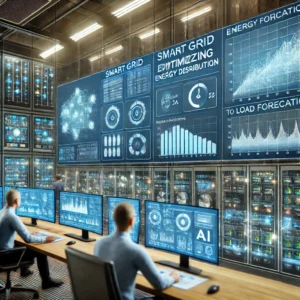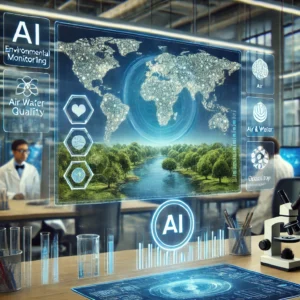
Artificial intelligence is playing a crucial role in addressing climate change, from optimizing energy usage to advancing environmental monitoring. This article explores how AI-driven solutions are helping tackle pressing environmental challenges. With detailed examples, case studies, and insights into AI applications in energy, agriculture, and biodiversity conservation, readers will discover the impact of AI in creating a sustainable future. Learn about the ethical considerations, partnerships, and future trends shaping AI’s role in environmental sustainability.
AI and Climate Change
As climate change poses growing risks to ecosystems and communities worldwide, the need for innovative solutions has never been greater. Artificial intelligence (AI) offers promising tools to address various environmental challenges, helping optimize energy consumption, reduce emissions, protect biodiversity, and improve disaster response. By processing large datasets and making predictions, AI can identify patterns and trends that enable scientists, policymakers, and industries to make informed decisions for a sustainable future.
This article provides an in-depth look at how AI is being used to combat climate change. We’ll explore key areas where AI is making an impact, discuss ethical considerations, and examine the partnerships and collaborations that are driving AI innovations for environmental sustainability.

Key Applications of AI in Combating Climate Change
AI applications are reshaping multiple sectors, enabling organizations to address climate-related issues more effectively. Below are some of the most impactful areas where AI is making a difference.
1. Optimizing Energy Usage
One of the primary ways AI can combat climate change is through optimizing energy usage. By reducing unnecessary energy consumption, AI helps lower carbon emissions and improve energy efficiency.
- Smart Grids and Load Forecasting: AI-powered smart grids analyze real-time data to optimize energy distribution based on demand. Machine learning algorithms predict load requirements, minimizing energy waste and reducing reliance on fossil fuels.
- Renewable Energy Forecasting: AI improves the efficiency of renewable energy sources, like solar and wind power, by predicting output based on weather conditions. This enhances the integration of renewable energy into power grids and reduces dependency on non-renewable sources.
- Building Energy Management: AI-driven systems monitor and adjust energy consumption in buildings by learning usage patterns and controlling heating, cooling, and lighting. Smart thermostats and energy management platforms contribute significantly to reducing energy consumption in commercial and residential spaces.
2. Environmental Monitoring and Protection
AI is instrumental in monitoring environmental changes, providing insights into the state of ecosystems, air quality, and water resources. With AI’s ability to process data from various sources, such as satellite imagery and IoT sensors, environmental monitoring becomes more accurate and responsive.
- Air Quality Monitoring: AI analyzes data from air quality sensors to detect pollution sources and predict pollution levels. Cities use this data to implement timely measures, reducing public exposure to harmful pollutants.
- Forest and Deforestation Monitoring: AI-powered satellite analysis tracks deforestation and illegal logging activities in real time. By identifying forest degradation, AI helps conservation organizations protect critical ecosystems.
- Water Quality and Resource Management: AI-driven sensors monitor water quality parameters like pH, turbidity, and contaminant levels, enabling authorities to take preventive actions and protect drinking water sources.
3. Climate Modeling and Prediction
AI plays a crucial role in climate modeling and forecasting by processing vast amounts of climate data, enabling more accurate and granular predictions.
- Weather Prediction: AI enhances weather models by analyzing historical data and real-time inputs, improving the accuracy of short- and long-term forecasts. This assists in disaster preparedness and response efforts.
- Climate Impact Assessment: Machine learning models predict climate impacts on agriculture, infrastructure, and biodiversity, helping governments and organizations plan for climate resilience.
- Carbon Emission Tracking: AI can estimate carbon emissions from various sources by analyzing satellite images and other data. This information is valuable for monitoring emissions reduction targets and informing climate policies.
4. Sustainable Agriculture and Food Systems
AI-driven solutions in agriculture are helping create sustainable food systems by optimizing resource usage, reducing waste, and enhancing crop resilience to climate change.
- Precision Agriculture: AI systems analyze soil health, crop growth, and pest patterns, allowing farmers to optimize water, fertilizer, and pesticide use. This improves yields while reducing environmental impact.
- Automated Irrigation Systems: AI-powered irrigation systems monitor soil moisture and weather forecasts to optimize water usage, ensuring crops receive the right amount of water without waste.
- Food Waste Reduction: AI predicts demand and optimizes supply chains, reducing food waste at various stages of production and distribution. This contributes to sustainable food systems and reduces greenhouse gas emissions from waste.
5. Biodiversity Conservation
AI technologies are supporting biodiversity conservation efforts by tracking species, monitoring habitats, and identifying threats to wildlife.
- Wildlife Tracking and Protection: AI-driven drones and camera traps monitor wildlife populations and habitats, identifying poaching activities and human encroachments. This helps conservationists protect endangered species.
- Ecosystem Health Assessment: Machine learning models assess ecosystem health by analyzing data from various sources, including satellite imagery and field sensors. This enables early detection of threats, such as invasive species or habitat loss.
- Coral Reef Monitoring: AI analyzes underwater images to monitor coral reef health, identifying bleaching events and other stress factors. Conservationists use this data to implement timely interventions.
Ethical Considerations in AI for Climate Change
While AI holds immense potential to address environmental challenges, ethical considerations must guide its development and deployment to avoid unintended consequences.
1. Data Privacy and Security
AI applications in environmental monitoring often involve the collection of large datasets, including data from individuals and communities. Ensuring data privacy and secure storage is essential to protect against misuse.
- Community Consent: Projects that monitor public resources, such as air quality or water pollution, should seek consent from affected communities and ensure data is used responsibly.
- Data Security: With the increasing reliance on AI-driven sensors, there is a risk of data breaches. Organizations must implement robust cybersecurity measures to protect sensitive environmental data.
2. Equity and Access
AI solutions should be accessible to all communities, especially those most affected by climate change. The technology must be designed and deployed in ways that benefit marginalized and vulnerable populations.
- Inclusive Technology: Ensuring that AI tools are accessible and affordable can help bridge the gap between developed and developing regions, enabling global cooperation in climate action.
- Addressing Disparities: Climate change disproportionately affects low-income communities. AI solutions should focus on addressing these disparities and prioritize projects that benefit vulnerable populations.
3. Environmental Footprint of AI
Developing and deploying AI models requires computational resources, which contribute to carbon emissions. Efforts must be made to minimize AI’s environmental footprint.
- Green AI: Researchers are working to develop energy-efficient AI models, known as “Green AI,” which consume less power during training and deployment.
- Renewable Energy Sources: Data centers that power AI systems should prioritize renewable energy sources to offset the carbon footprint of AI development.
Case Studies: AI Tackling Climate Change in Action
Case Study 1: Microsoft’s AI for Earth Program
Microsoft’s AI for Earth program supports projects that use AI to tackle environmental challenges, including biodiversity conservation, climate change, agriculture, and water management. The program has funded over 700 projects worldwide, demonstrating AI’s potential in environmental sustainability.
Case Study 2: Google’s Renewable Energy Forecasting
Google has developed AI models to improve renewable energy forecasting for its wind farms. By predicting wind output with greater accuracy, Google’s AI system optimizes energy usage and increases the integration of renewable energy into the grid, contributing to a reduction in carbon emissions.
Case Study 3: Conservation AI in Kenya’s National Parks
Kenya’s national parks use AI-powered camera traps and drones to monitor wildlife populations and prevent poaching. AI analyzes images in real time to identify animals and detect human activity, helping conservationists protect endangered species.
Case Study 4: IBM’s AI for Disaster Response
IBM’s AI for Disaster Response initiative uses machine learning to improve the speed and accuracy of disaster prediction and response. By analyzing weather patterns and historical data, IBM’s AI models assist in anticipating natural disasters like floods, helping communities prepare and respond more effectively.
Case Study 5: DeepMind’s Energy Optimization in Data Centers
DeepMind, an AI company under Google, uses machine learning to optimize energy usage in data centers. By adjusting cooling systems based on real-time data, DeepMind’s AI reduced Google’s data center cooling costs by 40%, illustrating how AI can directly reduce environmental impact.
The Future of AI in Environmental Sustainability
As AI technology continues to advance, its role in combating climate change will grow. Here are some emerging trends and areas of focus for the future:
- Real-Time Environmental Monitoring: AI-enabled sensors and drones will provide real-time data on environmental conditions, enabling faster responses to issues such as pollution and deforestation.
- Climate-Resilient Infrastructure: AI can help design infrastructure that withstands climate impacts, such as extreme weather events, by analyzing environmental data and predicting risks.
- AI in Carbon Capture: AI can optimize carbon capture technologies, identifying ideal locations and methods for storing carbon emissions, which will be crucial for achieving climate targets.
- Enhanced Collaboration: AI will facilitate collaboration between governments, organizations, and communities, enabling data sharing and cooperative efforts for climate action.
- Green AI Initiatives: Researchers will continue to focus on energy-efficient AI models to reduce the technology’s environmental footprint, ensuring AI’s sustainable growth.
FAQ
Q1: How does AI help reduce energy usage?
A1: AI optimizes energy distribution in smart grids, predicts renewable energy output, and manages energy consumption in buildings, helping reduce carbon emissions and improve efficiency.
Q2: What role does AI play in environmental monitoring?
A2: AI processes data from sensors and satellites to monitor air quality, water resources, and deforestation, providing real-time insights for conservation and environmental protection.
Q3: How is AI used in agriculture to address climate change?
A3: AI-driven precision agriculture optimizes resource usage, reduces waste, and enhances crop resilience, making agriculture more sustainable in the face of climate change.
Q4: What ethical concerns arise from using AI in climate change solutions?
A4: Ethical concerns include data privacy, equitable access to technology, and the environmental footprint of AI. Ensuring ethical AI deployment is crucial for inclusive and sustainable climate action.
Q5: What is the future of AI in combating climate change?
A5: The future includes real-time environmental monitoring, climate-resilient infrastructure, advancements in carbon capture, and the development of green AI initiatives to reduce AI’s carbon footprint.
AI’s role in addressing climate change is both promising and essential. By optimizing energy use, advancing environmental monitoring, and enhancing sustainable practices in agriculture and conservation, AI is helping build a more resilient and sustainable world. As technology advances, ethical considerations and collaborative efforts will be critical to ensuring AI’s positive impact on the environment.





